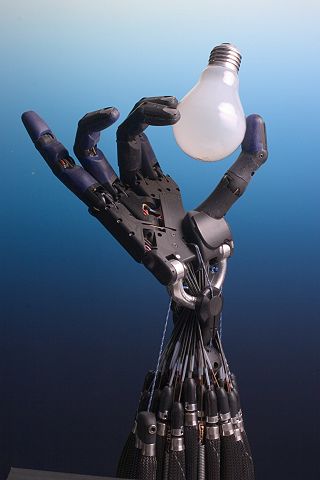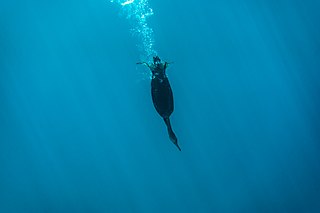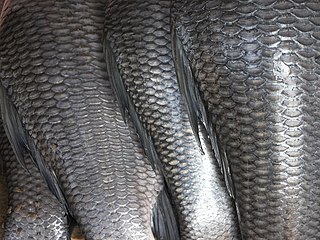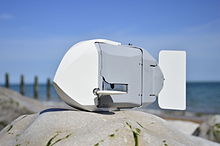
A fin is a thin component or appendage attached to a larger body or structure. Fins typically function as foils that produce lift or thrust, or provide the ability to steer or stabilize motion while traveling in water, air, or other fluids. Fins are also used to increase surface areas for heat transfer purposes, or simply as ornamentation.

Animal locomotion, in ethology, is any of a variety of methods that animals use to move from one place to another. Some modes of locomotion are (initially) self-propelled, e.g., running, swimming, jumping, flying, hopping, soaring and gliding. There are also many animal species that depend on their environment for transportation, a type of mobility called passive locomotion, e.g., sailing, kiting (spiders), rolling or riding other animals (phoresis).
Robot locomotion is the collective name for the various methods that robots use to transport themselves from place to place.

Fish locomotion is the various types of animal locomotion used by fish, principally by swimming. This is achieved in different groups of fish by a variety of mechanisms of propulsion, most often by wave-like lateral flexions of the fish's body and tail in the water, and in various specialised fish by motions of the fins. The major forms of locomotion in fish are:

An autonomous underwater vehicle (AUV) is a robot that travels underwater without requiring continuous input from an operator. AUVs constitute part of a larger group of undersea systems known as unmanned underwater vehicles, a classification that includes non-autonomous remotely operated underwater vehicles (ROVs) – controlled and powered from the surface by an operator/pilot via an umbilical or using remote control. In military applications an AUV is more often referred to as an unmanned undersea vehicle (UUV). Underwater gliders are a subclass of AUVs.

Remote control animals are animals that are controlled remotely by humans. Some applications require electrodes to be implanted in the animal's nervous system connected to a receiver which is usually carried on the animal's back. The animals are controlled by the use of radio signals. The electrodes do not move the animal directly, as if controlling a robot; rather, they signal a direction or action desired by the human operator and then stimulate the animal's reward centres if the animal complies. These are sometimes called bio-robots or robo-animals. They can be considered to be cyborgs as they combine electronic devices with an organic life form and hence are sometimes also called cyborg-animals or cyborg-insects.

Unmanned underwater vehicles (UUV), sometimes known as underwater drones, are submersible vehicles that can operate underwater without a human occupant. These vehicles may be divided into two categories: remotely operated underwater vehicles (ROUVs) and autonomous underwater vehicles (AUVs). ROUVs are remotely controlled by a human operator. AUVs are automated and operate independently of direct human input.
Michael Triantafyllou is Professor of Mechanical and Ocean Engineering in the Department of Mechanical Engineering, Director of the Center for Ocean Engineering, Head of the Area of Ocean Science and Engineering, and Director of the Testing Tank and Propeller Tunnel Facilities at the Massachusetts Institute of Technology (MIT). He is best known for his work on underwater robots, based upon and emulating the performance of fish, including the six-foot laboratory robot the RoboTuna, the free-swimming RoboPike (1998), and the RoboTurtle (2005).

Shark anatomy differs from that of bony fish in a variety of ways. Variation observed within shark anatomy is a potential result of speciation and habitat variation.

A Spherical Robot, also known as spherical mobile robot, or ball-shaped robot is a mobile robot with spherical external shape. A spherical robot is typically made of a spherical shell serving as the body of the robot and an internal driving unit (IDU) that enables the robot to move. Spherical mobile robots typically move by rolling over surfaces. The rolling motion is commonly performed by changing the robot's center of mass, but there exist some other driving mechanisms. In a wider sense, however, the term "spherical robot" may also be referred to a stationary robot with two rotary joints and one prismatic joint which forms a spherical coordinate system.

Robotics is an interdisciplinary field that involves the design, construction, operation, and use of robots..

Aquatic locomotion or swimming is biologically propelled motion through a liquid medium. The simplest propulsive systems are composed of cilia and flagella. Swimming has evolved a number of times in a range of organisms including arthropods, fish, molluscs, amphibians, reptiles, birds, and mammals.

The RoboTuna is a robotic fish project involving a series of robotic fish designed and built by a team of scientists at the Massachusetts Institute of Technology (MIT) in the US.

Certain species of fish and birds are able to locomote in both air and water, two fluid media with very different properties. A fluid is a particular phase of matter that deforms under shear stresses and includes any type of liquid or gas. Because fluids are easily deformable and move in response to applied forces, efficiently locomoting in a fluid medium presents unique challenges. Specific morphological characteristics are therefore required in animal species that primarily depend on fluidic locomotion. Because the properties of air and water are so different, swimming and flying have very disparate morphological requirements. As a result, despite the large diversity of animals that are capable of flight or swimming, only a limited number of these species have mastered the ability to both fly and swim. These species demonstrate distinct morphological and behavioral tradeoffs associated with transitioning from air to water and water to air.

A fish scale is a small rigid plate that grows out of the skin of a fish. The skin of most jawed fishes is covered with these protective scales, which can also provide effective camouflage through the use of reflection and colouration, as well as possible hydrodynamic advantages. The term scale derives from the Old French escale, meaning a shell pod or husk.

Bio-inspired robotic locomotion is a fairly new subcategory of bio-inspired design. It is about learning concepts from nature and applying them to the design of real-world engineered systems. More specifically, this field is about making robots that are inspired by biological systems, including Biomimicry. Biomimicry is copying from nature while bio-inspired design is learning from nature and making a mechanism that is simpler and more effective than the system observed in nature. Biomimicry has led to the development of a different branch of robotics called soft robotics. The biological systems have been optimized for specific tasks according to their habitat. However, they are multifunctional and are not designed for only one specific functionality. Bio-inspired robotics is about studying biological systems, and looking for the mechanisms that may solve a problem in the engineering field. The designer should then try to simplify and enhance that mechanism for the specific task of interest. Bio-inspired roboticists are usually interested in biosensors, bioactuators, or biomaterials. Most of the robots have some type of locomotion system. Thus, in this article different modes of animal locomotion and few examples of the corresponding bio-inspired robots are introduced.

Fins are distinctive anatomical features composed of bony spines or rays protruding from the body of Actinopterygii, Dipnomorpha, Actinistia and Chondrichthyes fishes. They are covered with skin and joined together either in a webbed fashion, as seen in most bony fish, or similar to a flipper, as seen in sharks. Apart from the tail or caudal fin, fish fins have no direct connection with the spine and are supported only by muscles. Their principal function is to help the fish swim.
Batoids are a superorder of cartilaginous fish consisting of skates, rays and other fish all characterized by dorsoventrally flattened bodies and large pectoral fins fused to the head. This distinctive morphology has resulted in several unique forms of locomotion. Most Batoids exhibit median paired fin swimming, utilizing their enlarged pectoral fins. Batoids that exhibit median paired fin swimming fall somewhere along a spectrum of swimming modes from mobuliform to rajiform based on the number of waves present on their fin at once. Of the four orders of Batoidae this holds truest for the Myliobatiformes (rays) and the Rajiformes (skates). The two other orders: Rhinopristiformes and Torpediniformes exhibit a greater degree of body caudal fin swimming.

Auke Jan Ijspeert is a Swiss-Dutch roboticist and neuroscientist. He is a professor of biorobotics in the Institute of Bioengineering at EPFL, École Polytechnique Fédérale de Lausanne, and the head of the Biorobotics Laboratory at the School of Engineering.

A peristaltic robot, also known as a worm-bot, is a robot that uses peristaltic locomotion to move, mimicking the movement of earthworms. Peristaltic locomotion relies on compressions and expansions of the metameres, or body segments, of earthworms. This method of movement is especially effective in navigating through narrow and intricate surfaces, making it particularly suitable for small millimeter-scale robots. Peristaltic robots have a wide range of applications, including endoscopy, mining operations, and pipe inspections.






















